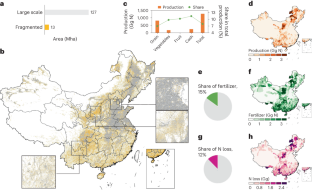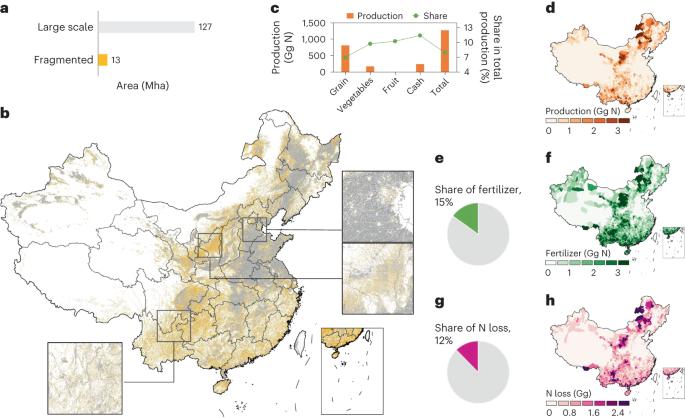Managing fragmented croplands for environmental and economic benefits in China
IF 23.6
Q1 FOOD SCIENCE & TECHNOLOGY
引用次数: 0
Abstract
Cropland fragmentation contributes to low productivity and high abandonment risk. Using spatial statistics on a detailed land use map, we show that 10% of Chinese croplands have no potential to be consolidated for large-scale farming (>10 ha) owing to spatial constraints. These fragmented croplands contribute only 8% of total crop production while using 15% of nitrogen fertilizers, leading to 12% of fertilizer loss in China. Optimizing the cropping structure of fragmented croplands to meet animal food demand in China can increase animal food supply by 19%, equivalent to increasing cropland proportionally. This crop-switching approach would lead to a 10% and 101% reduction in nitrogen and greenhouse gas emissions, respectively, resulting in a net benefit of US$ 7 billion yr−1. If these fragmented croplands were relocated to generate large-scale farming units, livestock, vegetable and fruit production would be increased by 8%, 3% and 14%, respectively, and reactive nitrogen and greenhouse gas emissions would be reduced by 16% and 5%, respectively, resulting in a net benefit of US$ 44 billion yr−1. Both solutions could be used to achieve synergies between food security, economic benefits and environmental protection through increased agricultural productivity, without expanding the overall cropland area. Using spatial statistics on a detailed land use map, the study highlights the impact of cropland fragmentation in China. Optimizing cropping structures to meet animal food demand or relocating fragmented croplands for large-scale farming can release the potential of the fragmented croplands for increased agricultural productivity and environmental protection.


在中国管理破碎的耕地,实现环境和经济效益
耕地破碎化导致低生产率和高撂荒风险。通过对土地利用详图的空间统计,我们发现,由于空间限制,中国有 10% 的耕地没有被整合为大规模耕作(10 公顷)的潜力。这些破碎的耕地仅占农作物总产量的 8%,却使用了 15% 的氮肥,导致中国 12% 的化肥流失。为满足中国的动物食品需求,优化破碎耕地的种植结构可使动物食品供应量增加 19%,相当于按比例增加耕地面积。这种作物转换方式将使氮排放量和温室气体排放量分别减少 10%和 101%,每年可带来 70 亿美元的净效益。如果将这些零散的耕地迁移到其他地方,形成大规模的耕作单元,牲畜、蔬菜和水果产量将分别增加 8%、3% 和 14%,活性氮和温室气体排放量将分别减少 16% 和 5%,净效益为每年 440 亿美元。这两种解决方案都可以在不扩大总耕地面积的情况下,通过提高农业生产率来实现粮食安全、经济效益和环境保护之间的协同增效。
本文章由计算机程序翻译,如有差异,请以英文原文为准。
求助全文
约1分钟内获得全文
求助全文

 求助内容:
求助内容: 应助结果提醒方式:
应助结果提醒方式:


